Surely like many other people of the Western world were there are 4 seasons and harsh winters, I became aware of the existence of Cape Verde thanks to Cesaria Evora. This must have been in the early 2000’s. She came from a place of many islands off the coast of Africa where Portuguese is spoken. To me, this place appeared remote and very exotic. Almost like a fantasy land. It was farther away in my imagination than Africa. Never in my life would I have imagined visiting this place. And yet here I am.
Porto da Palmeira, Ilha do Sal – 3 to 7 December 2016
After 7 days at sea, and a few hours waiting for the sun to rise before entering the port, we anchored in Porto da Palmeira. The island of Sal is the most North-Eastern of the 14 islands that form the archipelago of Cape Verde. Its port is one of 3 in the archipelago where boats may announce their arrival and departure to the naval authorities. Because of these 2 characteristics, Porto da Palmeira is the usual first stop in Cape Verde for sailors coming from Europe.
Porto da Palmeira has nothing of a European port. No berths, no pontoons, no electricity, no water, no showers, no security, no shipchandler… not even the inevitable “Port Restaurant” that can be found along every port in France and Spain. Instead, you anchor as in an anchorage, shower on your boat (everything goes into the port’s water) and use your dinghy to go to land. After manoeuvering around a good number of local fishing boats and the lines they leave in the water to tie up their boats, you are usually greeted by a few boys who offer to help you secure your dinghy, to watch over it while you’re away or bring your trash bags to the dump. Palmeira is mainly a fishing port. Fishermen bring in their catch daily to the lowest stone ridge of the pier where they clean out the fish and throw the heads and inners back in the water. Needless to say, we opted against a swim in the port!
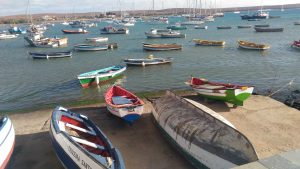
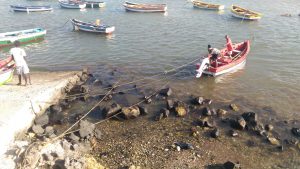
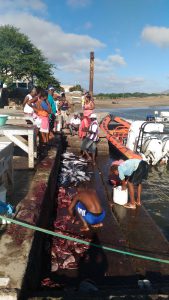
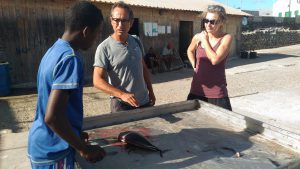
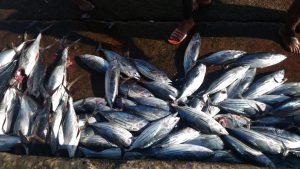
The town itself is desolate. Wide cobble stone streets. Stray dogs that either happily lounge under your restaurant table or bark at you, all depending on what its inner compass makes of you. Short houses, many of which are in a halted state. It’s sometimes difficult to say if a house is in ruins or being constructed or was abandoned while being constructed. These ghost houses are a sad sight and are witness to the general poverty. Water is scarce on most islands. On Sal, most of water comes from a desalinization plant, which is then pumped to local “fountains” where the people come to fill up jerrycans.
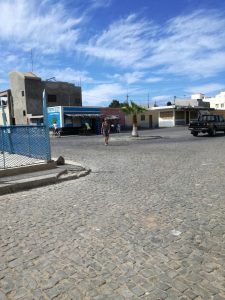
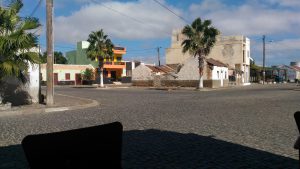
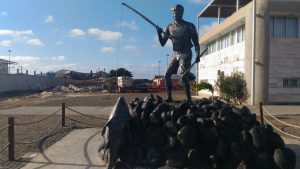
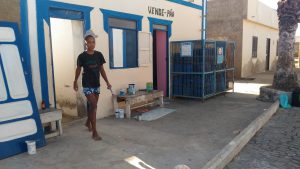
We visited Esparagus (yes, its name does originally come from asparagus plantations!), the largest city that’s a 10 minute drive from Palmeira, with the hopes of visiting a lively large city, but it was more of the same. Santa Maria in the South of the island is considered by purists as terribly touristic because of all the hotel developments. On Sal, it was the city I preferred. The tourist industry here is nothing like what can be found along the Spanish coast or the Canary Islands. No 6 storey hotel complexes here! Instead, 2 to 4 storey buildings that blend well into the landscape with a good number of quaint restaurants and shops. Walk a little further from the beach and you will find the same semi-abandoned buildings as anywhere else on Sal, but the money brought in by tourism seems to make the living a bit more fortunate.
In addition to water, another rarity here is food. In Palmeira we met a young Frenchman who moved here 5 years ago and opened a restaurant. He confirmed to us that the basic Cape Verdean meal consists of fish and rice. Fruit and vegetables are a luxury. Beef is even more so. The national dish is called cachupa, a sort of ragout made of beans, corn, fish and meat with an egg served on top. I like it! Cabo Verde also make excellent coffee on the island of Fogo. It’s excellent because it’s tasty without being acidic. Unfortunately, their production is so small and export is so expensive that it’s very hard to come by outside of the archipelago. I plan on stocking up before we leave. Our guide had warned that sailors crossing the Atlantic from Cape Verde are best to stock up on food in the Canary Islands as prices here are so high. Even if our boat is a tad too heavy, I’m very happy that we followed that advice. We bought 3 bags of food in Santa Maria, some fruits & vegetables, a bit of wine, coffee and yogurt… for a total of 68 EUR! That’s 94$ CDN. A staggering amount. Seeing that most people here make between 100 to 200 EUR per month, you quickly understand how wine, cheese and apples, even those produced in the archipelago, are out of bounds.
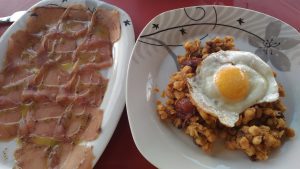
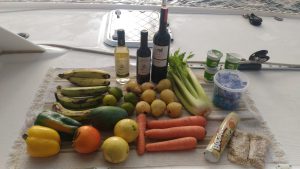
The locals are a mix of shy and curious. They seem generally reserved, but any man who has his fill of beer becomes sociable – as any man anywhere does! Those who easily approach you and right away ask you where you’re from are generally men from Senegal. Local crafts also tend to be from Senegal or elsewhere in Western Africa.
Sal wears its name well. For the past few years, the island has been exploiting its sandy beaches and strong North-Eastern winds to cater to the wind-sport enthusiasts. If you are not a kite-surfer heading to the Eastern Coast, the main attraction is a salt lake that’s in the middle of a crater where tourists come to float for a few minutes. So we went. I floated. Then became itchy. Essentially, not the highlight of my year.
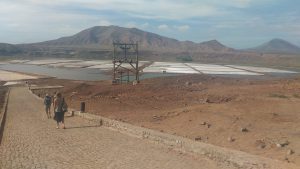
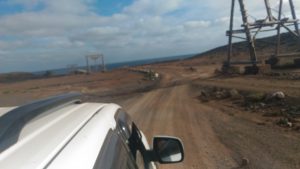
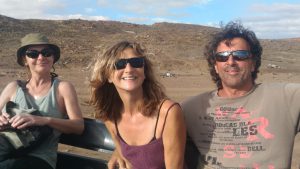
Pierrick’s friend Claire has come to visit us for 2 weeks. She arrived on Sunday 4 December. We have also had the good fortune to meet a couple who come from our home port! Dominique and Zeyno, on their boat Lucky 4. Zeyno is an artist and will be giving Pierrick some drawing lessons. We get along so well that we’ve decided to follow each other for a while, so it’s in a group of 5 that we continued our travels onward to Ilha da Boavista.
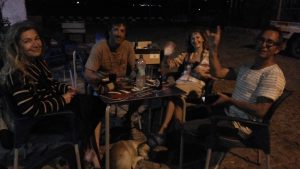
Claire, Dominique, Zeyno and Pierrick, & a stray dog lounged at our feet.
Porto de Sal Rei, Ilha da Boavista – 7 to 11 December 2016
Porto de Sal Rei is a real port but for freighters. Pleasure vessels anchor to the south of the port, protected by its jetty and Ilheu de Sal Rei, a small island off its coast. Again, we use our dinghy to get to town, where we beach it behind the fishing boats. No boys come to offer their services. Sal Rei is the biggest and most populated city of the island of Boavista – a sort of mix of Palmeira, Esparagus and Santa Maria. Senegalese men offer to help you out in any way possible. Italians have opened and own the restaurants, bars and bakeries. There is a sort of dépanneur (dep) owned by the local Chinese couple – in every town we’ve visited there’s a Chinese family who runs the convenience store, no joke! At last, we’ve landed in a city that’s both lively and traditionally Cape Verdean. Moreover, a long beach of white sand stretches to the South of Sal Rei where kitesurfers and surfers play in the breakers. It’s beautiful. It’s a little bit of paradise. The sound of the waves is almost constant. The water is clear so we can jump in from the boat.*
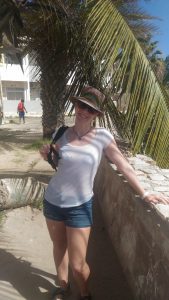
Sal Rei, Boasvista.
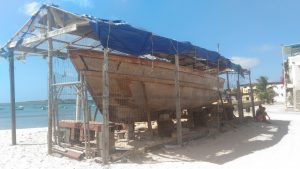
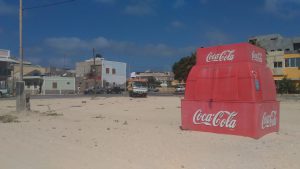
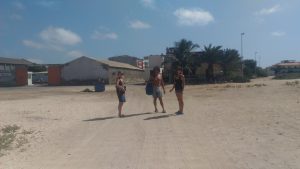
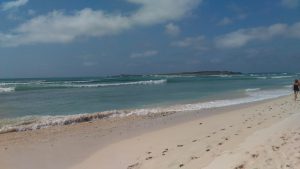
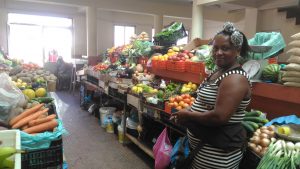
Apart from taking in the beauty of this place and visiting the immediate surroundings, we took a day to explore the rest of the island. My travel guide suggested leaving early in the day to avoid driving at night as there are no lights and no signs. The sun sets at 6:30 PM local time. By 9:30 we were on the road. We rented a 4-wheel drive jeep, the only sort of car recommended for the roads of Boavista, and started out by heading North. The paved road quickly became a cobble-stoned one, which quickly became a dirt road. The ride was very bumpy and once the novelty wore off, not pleasurable in the least. Still, we saw some wonderful landscapes with beautiful eroded rocks and wild goats and cows. We drove through Espingueira (a town transformed into an ecolodge that can only be visited upon reservation), Joao Galego and then stopped for lunch in Fundo das Figueiras, a very cute and colourful village where we ate a delicious typical Cap Verdean meal. After lunch while waiting for our coffees, a local man passed us and put a guitar in Pierrick’s hands. He can’t play. Claire did a bit, and then the man took his guitar and commenced an endless sodade (or at least I think it was a sodade, but it may be some other type of Cape Verdean music). How wonderful to share a good meal in good company topped off by beautiful live music.
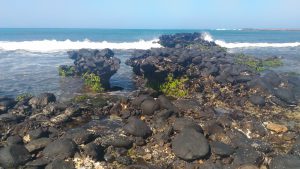
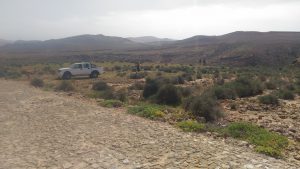
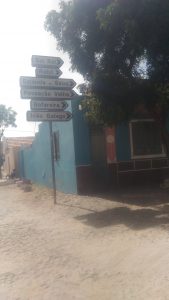
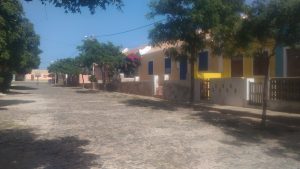
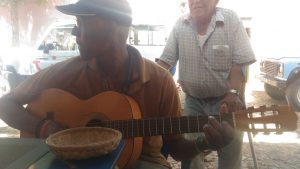
Our next objective was to travel along the Southern route to the beach of Santa Monica, reputed as one of the most beautiful beaches in Cabo Verde. The route was rough. It’s essentially a dirt road without any indications save for the tire marks left by the cars that passed before us. Luckily, the Boavista Ultramarathon was taking place the same day and along the road some rocks were painted white to show the way to the runners . We drove in the opposite direction and heartily encouraged any lone runner we encountered. We arrived at our destination an hour or 2 before the sun set. An unaltered stretch of white sandy beach. We stayed a while taking in the beauty of the place and chasing crabs. We didn’t have time to visit the desert that’s in the center of the island, but I think we were all happy to get back to Sal Rei and get out of the car! We finished the day with a nightcap at Wakan Bar. It’s tiny and constructed around a tree in the shape of a ship. It’s in the middle of the road right in front of where we had beached our dinghies. As a thank you for our patronage, the Italian owner brought our change with 3 little sculptures of tortoises, examples of the local burgeoning crafts.
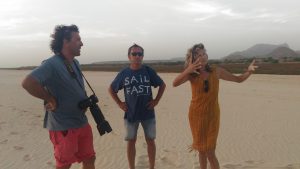
Boavista also wears its name well. This place is nothing if not beautiful vistas.
Cesaria Evora’s anthem, Sodade, translates into English as so:
Longing
Who will show you…
this distant way?
Who will show you…
this distant way?
This way …
to Sao Tomé?
The longing, the longing,…
The longing
For this land of mine, Sao Nicolau
If you write me letter,…
I will write you back
If you forget me,…
I will forget you…
Until the day…
You come back
The island she sings of, Sao Nicolau, is our next stop.